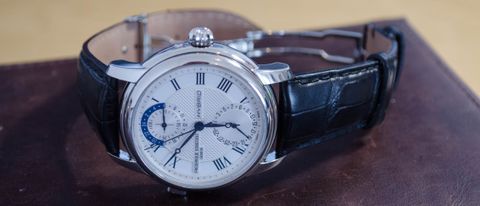Why you can trust TechRadar
Verdict
Frederique Constant describes the Hybrid Manufacture as the “world’s first 3.0 watch”, in that it blends a 1.0 mechanical watch with a 2.0 smartwatch. This, we feel, is a bit of a leap considering the limited smarts on offer here.
The Hybrid Manufacture is a beautiful Swiss watch with everything watch fans will expect for their £3,000 / $3,500.
It also adds a small sprinkling of smartness, but only enough to act as an occasionally useful distraction to the main event. Watch geeks will like the performance data, but the step tracking is nothing your smartphone can’t already do, and without automation the sleep tracking is generally more effort than it is worth.
Looking more broadly, it at least offers a tantalizing glimpse at what could become of Swiss mechanical watches.
But, given the industry's reluctance to embrace quartz in the 1970s - a move that put 1,000 Swiss watchmakers out of business in a disastrous decade - we wouldn’t count on connected Rolexes and Omegas becoming the norm just yet.
Who’s this for?

If you are in the market for a circa £3,000 / $3,500 Swiss watch and the smartwatch trend has piqued your interest, then by all means the Hybrid Manufacture will feed this curiosity.
If you do not currently wear a fitness tracker - and don’t count steps on your smartphone - this watch will provide you with data you won’t have seen before, which depending on your circumstances could just be the extra incentive you need to make the purchase over a more traditional alternative.
Should you buy it?

It’s a difficult question to answer because the Hybrid Manufacture finds itself in a class of one, with no real competition to speak of.
We like the approach Frederique Constant has taken here - demonstrating how Bluetooth and smartness can be seamlessly added to a traditional Swiss watch. The industry should applaud what it has done, and perhaps even follow suit.
But the execution falls a little below par. The watch is an interesting product and an indication of where the Swiss industry could go in the future, but for now it isn’t the complete package. Its roots remain firmly at the edge of Lake Geneva, not San Francisco Bay.
First reviewed: June 2018
Alistair Charlton is a freelance technology and automotive journalist based in London. His career began with a stint of work experience at TechRadar back in 2010, before gaining a journalism degree and working in the industry ever since. A lifelong car and tech enthusiast, Alistair writes for a wide range of publications across the consumer technology and automotive sectors. As well as reviewing dash cams for TechRadar, he also has bylines at Wired, T3, Forbes, Stuff, The Independent, SlashGear and Grand Designs Magazine, among others.


